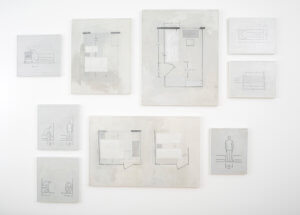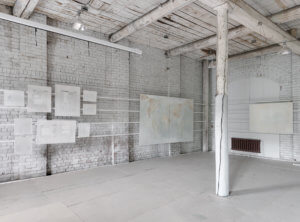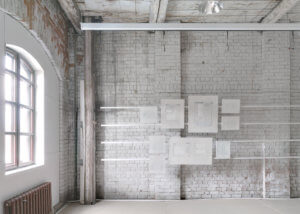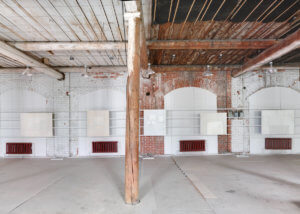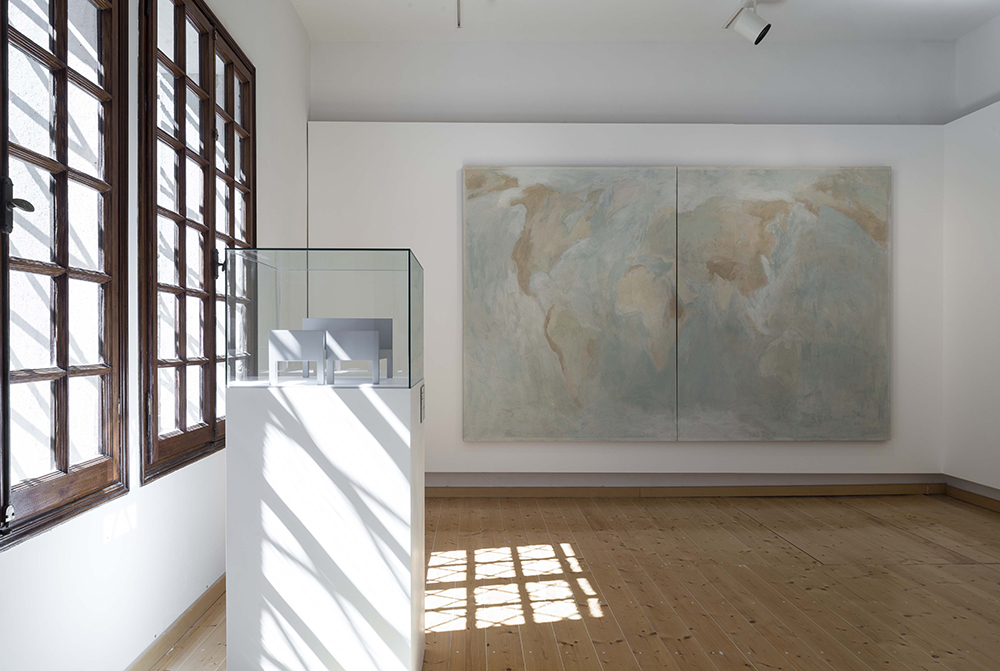On the Sleeping Arrangements in the Sixth Five-Year Plan
2012
“Humans […] are often present in Alexandra Paperno‚Äôs pale paintings, though they are often depicted as schematic embodiments of statistics relating to the Kruschchyovka blocks of the Soviet Union. The Soviet scheme named ‚ÄėOn Eliminating Excess in Design and Construction‚Äô was part of a five-year plan aimed at reducing housing costs based on standardisation and prefabrication. It drew on studies of how much space is needed for a bed, for tying one‚Äôs shoe laces, and so on. Partly ironic, party appreciative, the artist highlights the extreme rationalism which indeed provided if not great housing, at least decent dwellings for millions of people. As if to underline the presence of this type of housing across the globe, Paperno combines the paintings, filled with schematic figures and apartment floor plans, with an equally pale painting of a world map encompassing not only the ten time zones of the Soviet Union but also the rest of the world.”
Maria Lind
‘Elaborations on Late Modernist Housing Architecture: a New Genre within Contemporary Art’
The series consists of paintings of various sizes depicting plans of apartments in social housing projects, walls, and a World Map.
In 1955, the Communist Party adopted the resolution “On the Elimination of Excess in Design and Construction”. The task set for architects was development of standardized projects and standardized designs, dramatically reducing the cost of housing and making it accessible to the working class. The goal of the project was that in 1980 every Soviet family would greet Communism in a separate apartment. Thus started the Sixth Five-Year Plan (1956-1960), marking the beginning of mass construction of block khrushchevka houses.
The map of the world soars up under the unforgiving ratio of living conditions that have been planned down to the centimeter. If the sleeping arrangement has been devised correctly, the Soviet schoolchild, upon falling asleep in any of the ten time zones of the wide country, sees this map on the wall before him. It hangs in the bedroom as a reminder of the great conquests of the motherland and of victories yet to come on Earth and in space. Sleep and the painting gradually blur the registers of time and space.
Plans, maps and other symbols‚ÄĒconventional images devoid of meaning‚ÄĒtake on an entirely new tonality when brought to the canvas by the brush. The painting process instills new life into dead signs. It is an attempt to overcome the closed parochialism of artistic, social or scientific systems, an attempt to return to the subjective whole of practical experience. Among the external objects of contemplation is a bare wall showing only the shadows of things, or geometrically composed pictures of walls that look so much like floor plans. All these rhyming rectangles of the imagined past/future serve as a pretext for a very painterly metaphysics‚ÄĒa metaphysics of the single present, manifesting as a continuum of plastic modulations and constituting the central theme of this work devoted entirely to vision. It lives in the attention of the artist’s eyes and congeals in words and interpretations.
Exhibition view “On the Sleeping Arrangements in the Sixth Five-Year Plan‚ÄĚ
Curated by Ekaterina Inozemtseva
Smena Centre of Modern Culture, Kazan
May 16  Р July 5, 2015
Exhibition view of ‚ÄúThe Way of Enthusiasts,‚ÄĚ curated by Katerina Chuchalina and Silvia Franceschini, Casa dei Tre Oci, The 13th International Architecture Exhibition Collateral Event, Venice, ¬†2012
Exhibition view of Fifth Moscow Biennale of Contemporary Art “More Light”
Curated by Catherine de Zegher
Manege Central Exhibition Hall, Moscow
September 20‚ÄďOctober 20, 2013
Photographs by Yuri Palmin
[The Art Newspaper]¬†–ź–Ľ–Ķ–ļ—Ā–į–Ĺ–ī—Ä–į –ü–į–Ņ–Ķ—Ä–Ĺ–ĺ, ¬ę–ě–Ī –ĺ–Ī—É—Ā—ā—Ä–ĺ–Ļ—Ā—ā–≤–Ķ —Ā–Ĺ–į –≤ –Ņ–Ķ—Ä–ł–ĺ–ī —ą–Ķ—Ā—ā–ĺ–Ļ –Ņ—Ź—ā–ł–Ľ–Ķ—ā–ļ–ł¬Ľ
[–Ď–ė–ó–Ě–ē–° Online]¬†¬ę–ě–Ī –ĺ–Ī—É—Ā—ā—Ä–ĺ–Ļ—Ā—ā–≤–Ķ —Ā–Ĺ–į —ą–Ķ—Ā—ā–ĺ–Ļ –Ņ—Ź—ā–ł–Ľ–Ķ—ā–ļ–ł¬Ľ
[E-Flux] The Way of Enthusiasts

